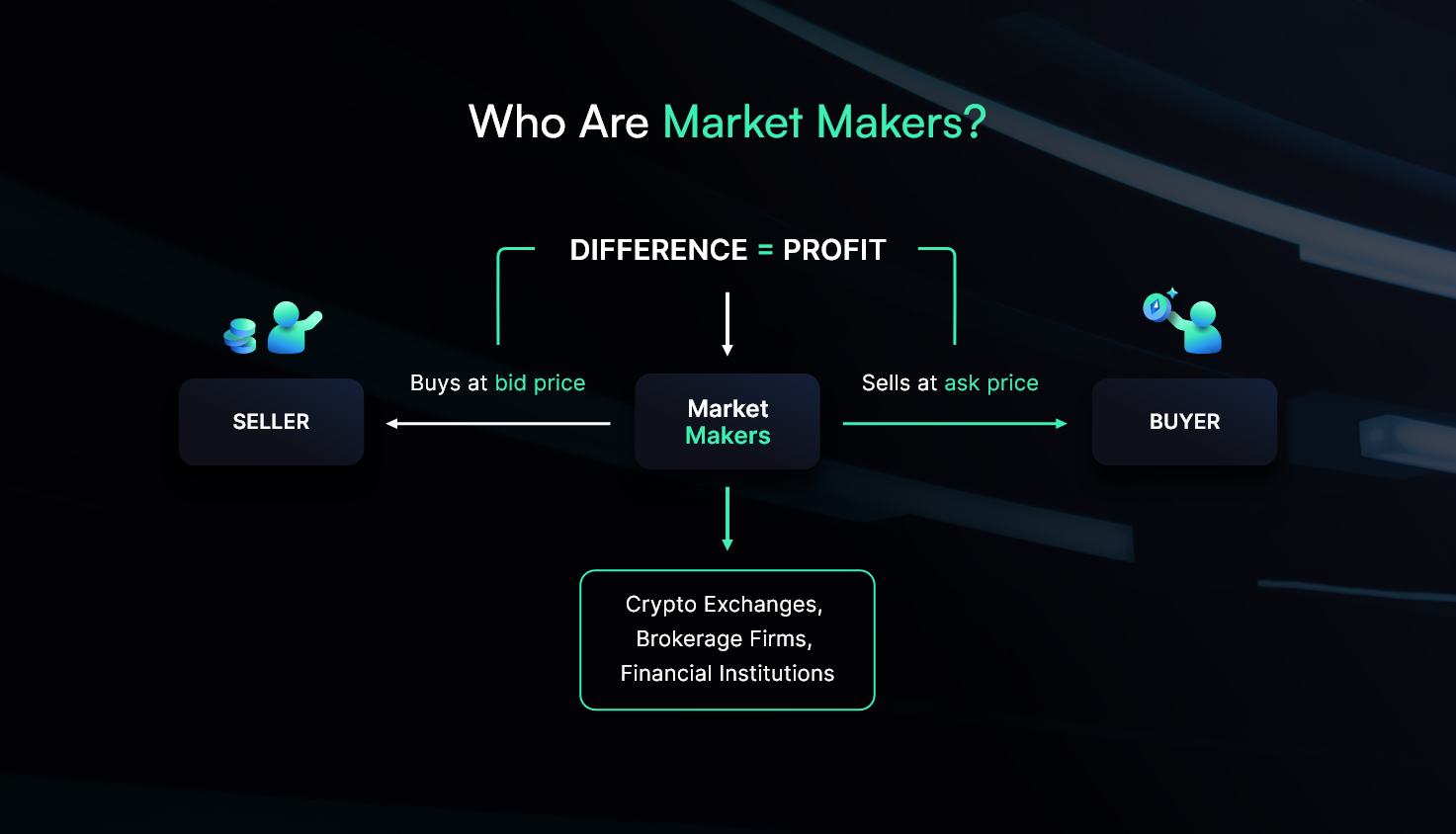Summarize with AI:
Updated May 3, 2025
Crypto market making is the practice of continuously placing buy and sell orders for digital assets to ensure liquidity on trading platforms. This activity helps stabilize prices, narrow bid-ask spreads, and reduce volatility, creating a more efficient and reliable market environment. Market makers earn revenue through the spread while playing a vital role in supporting liquid and accessible markets for both retail and institutional participants. This guide explores the core principles of crypto market making, key strategies for success, and the opportunities and risks shaping this critical function in 2025.
Crypto Market Making Guide: Mastering the Fundamentals
Market making plays a foundational role in today’s cryptocurrency landscape. Despite its importance, it remains misunderstood by many traders and token projects. At its core, crypto market making is the continuous practice of placing both buy and sell orders on a trading venue to provide liquidity. This enables smoother price discovery and faster trade execution. In 2025, as digital asset markets grow more fragmented and institutionalized, market makers are more critical than ever. They help keep order books active, prices stable, and new tokens tradeable even when organic volume is low. In doing so, they connect capital with innovation and support healthier trading environments across the ecosystem.
This article will help you understand the basics of crypto market making, the strategies involved, and why market makers are so important in keeping digital asset markets liquid and efficient. Written for both experienced trader or those just getting started in the crypto world, this guide will give you a clear understanding of how market making works and why it matters.
Role of a Crypto Market Maker
Crypto market makers are participants who continuously place both buy and sell orders to ensure liquidity on an exchange. Their activity reduces slippage, compresses bid ask spreads, and increases the chances of successful trade execution for all market participants. Market makers profit from the spread between the bid and ask prices. More importantly, they help absorb supply and demand shocks that would otherwise lead to rapid price swings. This consistency encourages participation from retail traders and institutional investors alike.
In short, market makers serve as a critical layer of trading infrastructure. They create confidence in a token’s liquidity and support exchanges in building healthy markets.

Requirements for Becoming a Market Maker
Becoming a market maker today requires more than capital. It demands reliable infrastructure, smart automation, and deep exchange relationships. Key requirements include:
-
Sufficient capital to support large order volumes and multiple trading pairs
-
Trading software with advanced algorithms for dynamic strategy adjustment
-
High speed connectivity to centralized and decentralized exchanges
-
Risk controls that monitor inventory exposure and manage volatility
-
Access to real time analytics and order book visibility
-
Exchange relationships that offer incentives, rebates or priority listings
These tools enable market makers to compete effectively and maintain presence across fragmented markets.
Three Market Making Strategies You Need to Know
In order to become a successful crypto market maker, you need practical strategies that help manage risk, maintain liquidity, and maximize profits. Below are three key strategies, with actionable examples, that can set you up for success in cryptocurrency market making.
1. Managing Spreads in Real Time
In 2025, managing the bid-ask spread requires real time decision making. Market makers use live volatility data, competitive quotes and inventory levels to decide how wide or narrow their spreads should be. The spread is where market makers earn their profits, but striking the right balance is key. For example, imagine you’re making a market for a cryptocurrency with a current price of $1000. You could set your buy (bid) price at $999.6 and your sell (ask) price at $1000.4. This $0.8 spread is your profit per trade.
As a market maker, you can adjust your spreads based on market conditions. In highly volatile markets, you might widen the spread to cover potential risks. On the other hand, during periods of high liquidity and competition, narrowing the spread (e.g., $999.8 to $1000.2) can attract more trades, increasing volume and compensating for a smaller spread.
2. Controlling Inventory Across Markets
Holding too much of one asset can create risk. Market makers use automated systems to monitor their holdings and adjust their trading behavior to stay within target ranges.
Set an upper and lower limit for how much of each asset you’re willing to hold. For example, if you’re market making on a platform with ETH and your goal is to hold no more than 100 ETH, you could automatically adjust your bids to sell excess ETH when your inventory exceeds this threshold. Conversely, if your inventory dips below 50 ETH, adjust your bids to buy more until you’re back within your target range.
3. Using Smart Routing and Arbitrage
Automation plays a huge role in modern market making. By using automated trading software, market makers can place thousands of trades across multiple exchanges in a fraction of the time it would take manually. For instance, an algorithm can automatically adjust bid-ask spreads based on current market conditions or execute arbitrage strategies between exchanges to capitalize on price differences.
Start by using market-making software that integrates with multiple crypto exchanges via APIs. For example, configure your algorithm to monitor prices on platforms like Binance and Coinbase. If it notices a 1% price difference for the same asset, it can buy low on one exchange and sell high on another, locking in small profits with minimal manual effort.
These examples show how you can apply specific strategies to succeed as a market maker. With a combination of spread management, inventory control, and automation, you can build a profitable and sustainable market-making business in the crypto space.
Financial Benefits and Market Value
Market making offers several (exceptionally lucrative) financial benefits, primarily through earning profits from the spread between buy and sell prices. By consistently placing buy and sell orders, market makers capture small but frequent gains, which can accumulate into significant profits over time. In addition to spreads, many crypto exchanges offer rebates or reduced trading fees to incentivize market makers, further boosting their earnings.
Beyond direct financial rewards, market makers play a primary role in increasing liquidity across crypto exchanges. This added liquidity creates more trading opportunities for other participants, helping to stabilize prices and encourage larger trading volumes. By maintaining a steady flow of transactions, market makers make crypto markets more accessible and efficient for all traders.
Risks and Challenges in 2025
Crypto market making, while profitable, comes with its share of challenges. Market volatility is a major risk, as sudden price swings can lead to losses if market makers hold too much of an asset during a downturn. Managing this inventory risk, while still providing liquidity, requires careful (and constant) attention. Another challenge is staying competitive, as market makers must maintain tight bid-ask spreads to attract traders, all while other market makers are competing for the same trades.
To address these challenges, automated trading algorithms can be used to adjust bid-ask spreads based on real-time market conditions, reducing the impact of sudden price fluctuations. Risk can also be managed by hedging positions across various exchanges or assets, reducing exposure to any single market shift. By employing these strategies, market makers can balance risk and reward, maintaining profitability in volatile and competitive markets.
Final Thoughts
Becoming a successful crypto market maker requires a combination of strategy, technology, and careful risk management. By mastering techniques like managing bid-ask spreads, controlling inventory, and leveraging automation, market makers can overcome the challenges presented by cryptocurrency markets. In addition to the financial benefits, market makers play an important role in maintaining liquidity and stability in the digital asset spectrum. With the right tools and approach, market making offers a rewarding and lucrative path in the world of higher level crypto trading.
Shift Markets stands as the industry leader in crypto market making software and technology, offering advanced tools like synthetic pair functionality and access to abundant liquidity. With Shift’s platform, market makers can refine their strategies and manage risk with greater precision. Partner with Shift Markets to strengthen your presence in the digital asset market.
Share this article:
Want to learn more?
Let us save you time by walking you through what Shift can do for your business!



